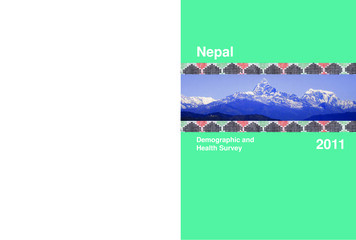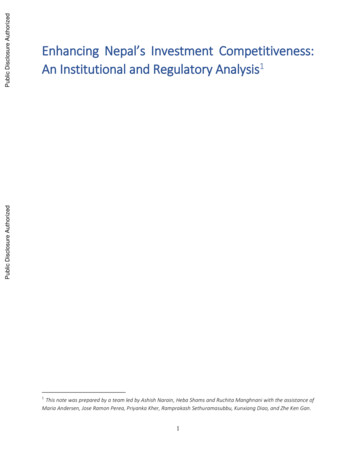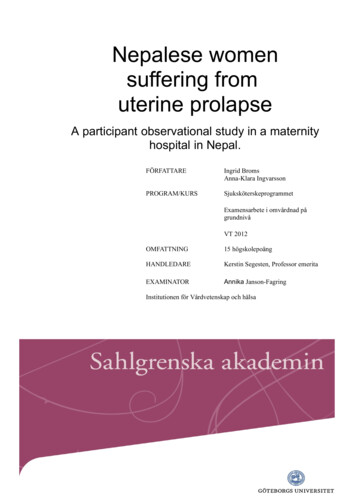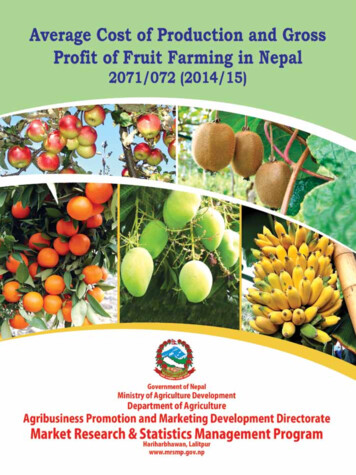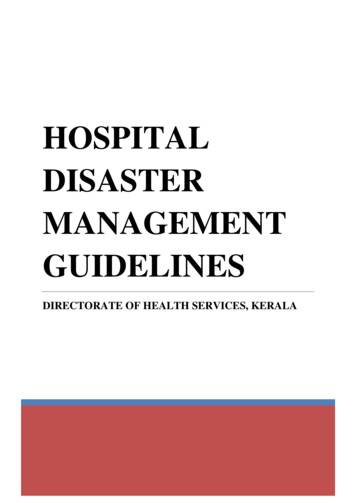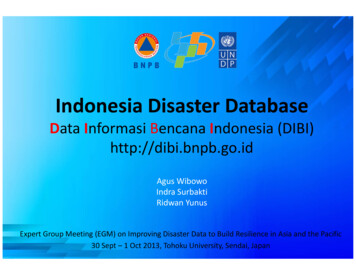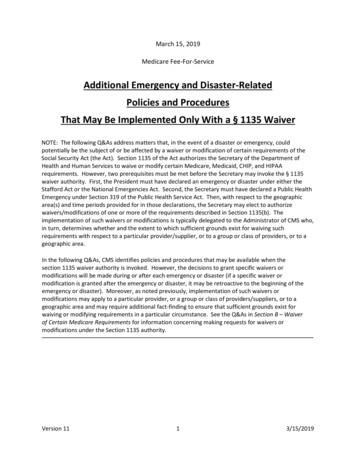
Transcription
National Position Paper for theGlobal Platform on Disaster Risk Reduction22-26 May 2017, Cancun, MexicoDisaster Risk Management in Nepal:Status, Achievements, Challenges andWays ForwardGovernment of NepalMinistry of Home Affairs
Disaster Risk Management in Nepal:Status, Achievements, Challenges and Ways Forward1.0 OverviewSituated in a unique geophysical setting of a relatively young and emerging mountain range,and a highly varied climate, Nepal is exposed to several recurrent hazards every year. Due tolack of land use planning and zoning, rapid and unplanned urbanization, low per capita income,loss of natural vegetation in upstream coupled with inadequate preparedness, and extantvulnerabilities, Nepal’s exposure to multi-hazards often turns into medium to mega disasters.The national dataset on disaster events and losses, maintained and updated by Ministry ofHome Affairs (MoHA),1 has recorded more than a dozen types of hazards.Nepal’s exposure to disaster risks is heightened by extreme weather conditions and climatechange impacts.2. Water-induced disasters (namely flash floods, riverine floods and landslides),despite being the most predictable events cause increasing human sufferings every year. Interms of human loss, epidemic, earthquake, landslide, flood, fire, and thunderstorm appear asthe key hazards claiming most lives. Fire, flood, thunderbolt, landslide and earthquake, however,are responsible for heavy loss of public infrastructure, private property and livelihoods.Although not a recurrent phenomenon, earthquake is the most significant hazard in Nepalresulting into serious humanitarian crises.3 The Gorkha Earthquake 2015 alone led to 8,970casualties, 22,300 injuries and destruction or damage of more than 800,000 houses andheritage sites. Almost one-third of the population was impacted and similar proportion ofGDP was lost due to this earthquake. Government of Nepal immediately launched relief andrecovery operations amidst overwhelming voluntary supports from communities, academia,media, NGOs, INGOs, private sector, bilateral and multi-lateral development partners, andfriendly nations. The Post Disaster Needs Assessment (PDNA) accomplished within a month of theearthquake not only assessed the damage and loss due to the earthquake, but also outlined arecovery strategy together with an estimation of recovery cost for 23 thematic areas.42.0 Disaster Profile of NepalNepal has a fragile geology and steep topography making it the 20th most disaster-pronecountry in the world. With regard to the relative vulnerability to climate change related hazards,1There are also few other datasets available. The MoHA dataset is now maintained in Nepal DRR Portal by National EmergencyOperation Centre. Alternatively, National Society of Earthquake Technology (N-SET) also maintains DesInventar database. Thirdly,Nepal Red Cross Society (NRCS) also maintains its own dataset of disaster events in Nepal but there is wider gap of NRCS datasetwith MoHA dataset. Finally, Department of Water-Induced Disaster Prevention (D-WIDP) also publishes national data on waterinduced disaster loss annually.2They include avalanche, cold wave, drought, frost, hailstorm, heat wave, snowstorm, storm, thunder storm, windstorm, amongothers.3Note that Nepal is considered the 11th most earthquake-prone country in the world (NPC, 2015).4The PDNA came up with an estimation of US 6.7 billion for the rehabilitation and reconstruction costs over a number of years,which the Government later revised the figure to nearly US 9 billion.1
earthquakes and flood hazards, Nepal ranks, respectively, in the 4th, 11th and 30th among 200countries of the world. Nepal continuously faces disaster impacts of high magnitude andintensity from a multitude of natural hazards.Table 2 reveals more than a dozen of hazards in Nepal, drawn from the active dataset maintainedby the MoHA, covering a period of 45 years (1971 to 2016). A total of 21,856 disaster eventshave been recorded during this period. Annually, Nepal is exposed to approximately 500 eventsof disaster on average and fire is one of the most recurrent hazards. Number of fire incidenceswas recorded 8,721 times, followed by flood (3,950 times), epidemic (3,452 times) and landslide(3,246 times).Epidemic is critically important in the sense that it is one of the single most killer hazards claimingthe lives of more than 16,583 people (41.8 percent of the total disasters-induced deaths) duringthe period, though the trend is decreasing. It is followed by earthquake, landslide and flood.Table 2 also reveals the number of persons injured, number of houses and heritages damagedor destroyed, and the number of families affected by the disasters. It reveals that the numberof persons injured due to disasters is double (a total of 79,147 persons) than the number ofdeath. Epidemic and earthquake are the two most important disasters in terms of human injuryaccounting for 91 percent of the total.Table 2: Major Disasters in Nepal and the Damage and Loss, 1971-2016Disaster typeEpidemicNo. ofdeathNo. ofpersonsmissingNo. ofpersonsinjuredNo. of housesdamaged ordestroyedNo of affectedfamiliesNo. 37,1401,711515-83-2,393390EarthquakeCold waveSnow storm877---5Avalanche1637--2Wind storm2-1121519144Hailstones/heavy 935779,1471,320,2575,945,28821,856* This data is recorded since 2016 only. It includes high altitude, boat capsized, snake bites, wild animal attack and others.In terms of property loss, during the period of last 45 years, a total of 1,320,257 houses wereeither destroyed or damaged. Of this, 982,855 (or 74.4 percent) houses were destroyed byearthquake alone, followed by flood. Likewise, a total of 5,945,288 families have been affectedby these disasters, of which flood is attributed to affecting a large number of families (62.4percent of the total), followed by earthquake, landslide, and epidemic. It is important to notethat the Gorkha Earthquake 2015 has dramatically altered the disaster statistics of the country.2
3.0 Gorkha Earthquake, 2015 and National RecoveryInitiativesOn Saturday, 25 April 2015, a 7.6 magnitude earthquake struck Barpak in the historic districtof Gorkha, about 76 km northwest of Kathmandu. Nepal had not faced a natural shock ofcomparable magnitude for over 80 years. The catastrophic earthquake was followed by morethan 450 aftershocks greater than magnitude 4.0 in Richter scale. Four aftershocks were greaterthan magnitude 6.0, including one measuring 6.8 which struck 17 days after the main shockwith the epicenter near the Mount Everest.Almost one-third of the population of Nepal in 31 out of 75 districts has been impacted bythe earthquake. Over 800,000 houses and heritages were destroyed or damaged. 14 districtswere declared ‘severely/ crisis-hit’ for the purpose of prioritizing rescue and relief operationsand another seventeen districts were declared ‘heavily hit or affected.’ The destruction waswidespread covering residential and government buildings, heritage sites, schools and healthposts, rural roads, bridges, water supply systems, agricultural land, trekking routes, hydropowerplants and sports facilities.Nepal’s National Disaster Response Framework (NDRF) served as a key tool for coordination ofearthquake response, facilitating decisions and instructions from the central to districts. Thefirst meeting of the Central Natural Disaster Relief Committee (CNDRC) was held immediatelyafter the earthquake, with the National Emergency Operation Centre (NEOC) providing aninitial report to the CNDRC, recommending a focus on Search and Rescue (SAR), and lifesavingactions. Financial resource from the Prime Minister Natural Disaster Relief Fund was immediatelyallocated, and the government’s cluster mechanism was instantly activated.Government of Nepal made an official request for international assistance within hours of theearthquake. Several meetings with donor communities were convened to seek and coordinateinternational assistance for search and rescue and immediate relief operations. With the limitedtrained human resources and equipment available, Nepal Army (NA), Nepal Police (NP) andArmed Police Force (APF) carried out effective SAR operations. They were backstopped bydozens of international military SAR teams under the coordination of Multi-National MilitaryCoordination Centre. The network of NGOs and INGOs based in Nepal swiftly rallied to supportcommunity relief efforts. Several national and international volunteer groups, businessassociations, humanitarian agencies (especially of youth and professionals like doctors andengineers) government employees, political parties and members of community basedorganizations were voluntarily mobilized in treatment of injured, setting up temporary shelters,supplying foods and non-food items.National Reconstruction Authority (NRA) was established in 25 December 2015 with mandatefor five years to lead and manage the recovery, reconstruction and rehabilitation activities ofthe earthquake affected infrastructures and families of 31 districts. The NRA’s overall goal is topromptly complete the reconstruction works of the infrastructures destroyed or damaged bythe earthquake with Build Back Better approach. It has formulated a Post Disaster RecoveryFramework (PDRF) (2016-2020) on the basis of PDNA. The government has sufficiently allocated3
the budget for reconstruction, rehabilitation and recovery initiatives and the NRA is providingtechnical support to individual household reconstruction and livelihood rehabilitation activities.Reconstruction activities are underway in the EQ affected district with support from governmentand non-government agencies. So far 22,234 private houses are complete and 49,828 privatehouses are being constructed, 200 health centers completed and 100 under construction, 1869educational institutions completed and 1561 ongoing, 89 public buildings completed and 36ongoing. Similarly, construction of 89 archeological heritages are complete and 36 are ongoing.The reconstruction process has followed principle of Building Back Better through adoption ofnational building codes.4.0 Policy, Legal and Institutional FrameworksDRM in Nepal is governed by the Natural Calamity (Relief ) Act, 1982 which establishedinstitutional mechanism at various levels (Central, Regional, District and Local) for effectivedisaster management focusing primarily on preparedness and response. Now, considering theimportance of disaster risk reduction, the Constitution of Nepal has clearly spelled out disastermanagement functions in all the three-tiers of government.Moreover, disaster risk reduction began to receive more attention from Government sidesince the 10th Five Year Development Plan (2002-2007) and the subsequent periodic plans.Furthermore, in alignment with Nepal’s commitment to the HFA, the Government of Nepalapproved the National Strategy for Disaster Risk Management in 2009. This Strategy outlined29 priority activities for risk reduction and mitigation. Box 1 presents major policy frameworkson DRM in Nepal.Box 1: Existing legal and policy framework on DRMlllllllllConstitution of NepalNatural Calamity (Relief ) Act, 1982Local-self Governance Act, 1999National Strategy on Disaster Risk Management, 2009National Disaster Response Framework, 2013Guidance Note on Disaster Preparedness and Response Planning, 2011National Guidelines for Search and Rescue, 2014District Disaster Preparedness and Response PlansStandard Operating Procedures of NEOC (and DEOCs)Recently, Government of Nepal has also initiated a process to promulgate a new comprehensiveand forward looking Disaster Risk Reduction and Management Bill for an effective DRM effortwhich would prioritize DRM across different levels of government, with a proposed DisasterManagement Council chaired by the Prime Minister and a dedicated institution. It is hoped thatafter establishment and institutionalization of strong disaster risk reduction and managementsystem including Disaster Management Information System (DMIS), disaster risk reduction,preparedness and response capability of the country will be strengthened and more robustdata and information will be readily available for risk informed financing and planning in theoverall development process.4
Moreover, Government of Nepal has currently given priority to formulating National DRR Policyand Strategic Action Plan in line with SFDRR through a consultative and participatory processby engaging key government agencies, donors, UN agencies, non-government organizations,private sectors and humanitarian communities. Similarly, Government of Nepal is also planningto formulate and implement sub-national level strategies so as to fulfill the target of SendaiFramework.Finally, in order to mainstream DRR into overall development planning process and strengthencross-sectoral planning, DRR and CCM focal points have been established and streamlined inkey ministries and agencies. Similarly, mainstreaming guidelines and urban resilience strategyformulation along with risk-sensitive land use planning activities are being undertaken by keyministries.5.0 Global and Regional CommitmentsGovernment of Nepal has been actively participating in all world conferences on disastermanagement (Yokohama, 1994; Hyogo 2005; and Sendai 2015), global platforms which occursin two year intervals from 2007 onwards, and in the Ministerial Conferences on Disaster RiskReduction in Asia. Moreover, Nepal is one of the signatories to these world conferences and hasexpressed commitment to fulfill its obligations and priority actions within the given time frame.Yokohama, Japan (1994): The first world conference on disaster management was held inYokohama, Japan in 1994 where Nepal actively participated. Following to the commitmentsmade by Nepal and in line with the Yokohama Strategy, the Government of Nepal had prepared"National Action Plan on Disaster Management in 1996" incorporating all phases of the disastermanagement cycle. .Hyogo, Japan (2005 - 2015): The second world conference on disaster reduction managementwas held in Kobe, Hyogo, Japan in 2005 and Nepal participated and endorsed the goals andpriorities for action between 2005 and 2015. Integration of DRR into sustainable development,develop and strengthen institutions to build resilience to hazards and build capacities foremergency preparedness, response and recovery were Nepal’s major goals under HFA.Sendai, Japan (2015 - 2030): The Sendai Framework for Disaster Risk Reduction (SFDRR) 20152030 was adopted in Sendai, Japan, on March 18, 2015. The SFDRR’s four priorities for actionand seven global targets will be achieved by 2030, through the National Policy and StrategicAction Plan for DRR currently being formulated by the government in wider consultation withthe stakeholdersAsian Ministerial Conference on Disaster Risk Reduction (2016): The Asian MinisterialConference on Disaster Risk Reduction (AMCDRR), held in New Delhi in November 2-5, 2016,endorsed the Asian Regional Plan for the implementation of the SFDRR for coming 2 years(2016 – 2018) with specific targets. The regional plan will be monitored and reviewed in everytwo year interval at regional level.Nepal being an active UN member state and signatory to the global and regional commitmentson disaster risk reduction is entitled to fulfill its obligations related to disaster risk reduction and5
management. Nepal is trying its best with its limited trained human and financial resources toachieve all global targets and the priorities for action by 2030. However, Nepal needs furthertechnical and financial support from development partners and friendly nations.6.0 Key National AchievementsNepal has achieved notable progress in disaster risk management during the last few decades.A number of legal, institutional and policy frameworks are already in place. Likewise, the NewConstitution of Nepal has made provisions for disaster management at all levels of government.As per provisions of Natural Calamity (Relief ) Act, 1982, Disaster Relief Committees at thecentral (CNDRC), regional (RNDRCs) and district (DDRCs) levels have been established and aremade functional to support effective disaster preparedness and response through adoption ofvarious policies, guidelines and standard operating procedures. Similarly, the Prime MinisterNatural Disaster Relief Fund, Central Natural Disaster Relief Fund and other operational levelfunds have also been created, which become operational at the time of disasters.All relevant government agencies have designated senior officials as Disaster and ClimateChange Focal Person. Hence there is a good pool of human resources dedicated to DRM/CCAfront and sharing and exchange of ideas has become more effective. Similarly, Governmenthas prioritized mainstreaming of DRR into development planning process, with DRM beingintegrated into the national periodic plans. In addition, community based disaster managementactivities in different disaster prone areas have been initiated and have proved to be instrumentalfor raising awareness and reinforcing mutual- and self- help spirit at community level.Government of Nepal has prepared and implemented a fifteen-year Sustainable DevelopmentAgenda of Nepal (2002-2017). Similarly, Government has incorporated disaster managementsubjects in school curricula since the mid-90s. Likewise, several academic and educationalinstitutions have started various programs on disaster management. Currently, majority ofthe schools have the school safety programs and School Disaster Management Plan in place.Similarly, hospital preparedness programs are also being implemented in public and privatehospitals and hub hospital concept is implemented throughout the country.National Emergency Operational Centre (NEOC) has been established within Ministry ofHome Affairs, which is now functioning smoothly. Likewise, 54 Emergency Operation Centers(EOCs) are operational at district and regional levels and Government is planning to expandEOC network to cover all 75 districts in the short term and all local level in the medium andlong term. The NEOC and EOCs directly support in collecting and coordinating disaster relatedinformation, response, immediate relief and humanitarian assistance. Similarly, basic level EarlyWarning System has been established in the five major river basins, which are linked to EOCsand the communities. Several flood-prone basins have early warning systems establishedwhich are capable of transmitting automatic alert to the residents via SMS about increasingriver water levels and potential floods. Noting the high risks posed by Glacial Lake OutburstFloods, the government in partnership with UNDP has recently installed a controlled drainagesystem in one of Nepal’s most high-risk glacial lakes in Imja. The system has successfully reducedthe water level of the lake by 3.4 meters, which has substantially reduced the risk of outburstflooding in the downstream.Community-led Disaster Risk Management activities ahve been supported by the government6
through enabling frameworks and policies, with 9 Minimum Characteristics being identified bythe government as critical for a resilient community.Moreover, 83 open spaces have been identified within Kathmandu Valley for shelter in theevent of major disasters and in several such open spaces infrastructure development is underconstruction. Efforts are being made to ensure supply of safe drinking water, emergency kits,and shelter with warehouse capacity. Government is mulling over identification ofopen spacesin other densely populated cities outside of Kathmandu Valley as well.Furthermore, implementation of National Building Code (NBC) has been made mandatoryin all municipalities. Larger cities within the Kathmandu Valley like Kathmandu and Lalitpurare implementing an innovative, online electronic building permit system. Likewise, masontrainings on safe building construction practices as per the NBC are being organized by bothgovernment and non-government organizations. Retrofitting of critical infrastructure likehospitals and schools are also being undertaken in collaboration with several developmentpartners.Institutionalization of a robust Disaster Management Information System (DMIS) has beeninitiated with the establishment of DRR portal as one point shop to facilitate collection,analysis and dissemination of disaster related information. Likewise, cluster approach has beeninstitutionalized for effective implementation and better coordination in disaster management.The Government of Nepal has already formulated a National Strategy on Search and Rescue(SAR) and initiated a process to operationalize the medium and light SAR teams as well. GetAirport Ready for Disasters (GARD) is another significant activity that Nepal has initiatedcovering Kathmandu and Nepalgunj airports. Establishment of the Humanitarian Staging Areais one of the major activities that furthers the readiness of airports in face of disasters in Nepal.Establishment of the disaster preparedness network (DP-Net) was another milestone to fostercoordination among disaster management related government and non-government agenciesand serve as a bridge between them. A common radio frequency for responders has alreadybeen agreed upon.Furthermore, Government of Nepal has established four regional warehouses for stockpilingof emergencies supplies in respective areas. Currently, one warehouse is under constructionand Government is planning to establish several more warehouses in each state covering allgeographical areas.7.0 ChallengesSince the declaration of new Constitution of Nepal in September 2015, Nepal is passing througha transition of state restructuring from unitary centralized system of governance to federaldecentralized system of governance. The government is drafting new comprehensive disasterrisk reduction and management bill as per the Constitution of Nepal. In this context, the majorchallenges that Nepal faces are as follows:1.Nepal’s existing disaster management law and institutional arrangement is responsecentric giving more attention to providing rescue and relief in the aftermath of a disasterand does not fully support disaster risk reduction and preparedness for recovery which is7
essential for building resilient communities and nation. In this context, there is dire needfor comprehensive disaster management legislation that encompasses the entire disastermanagement cycle with appropriate institutional set up that will remain relevant in thechanged national context.2.Despite on-going efforts on mainstreaming disaster risk reduction into developmentplanning, which is moving ahead rapidly, the process has faced several setbacks andchallenges due to inadequate technical skills and willingness to shift to risk-informed,evidence based development planning. Thus, disjoint remains in approaches for integratingdisaster risk reduction and climate change adaptation into national development planning.3.As evident by Gorkha Earthquake of 2015, Nepal’s capability to respond to mega disaster ishighly constrained by limited high-tech equipments and specialized capacities to conducteffective SAR operations. It has also limited capacities to leverage advanced technologiesin coordinating and mobilizing international humanitarian support at the time of megadisasters.4.Nepal needs to enhance its technical and functional capacities to fully utilize availableexpertise, experiences, research, and human resources available within and outside theregion to support its on-going efforts. Nepal can benefit from cross learning betweenthe countries in the area of early warning, raising technical skills, disaster managementinformation system upgradation and information sharing, hazard and risk mapping anddeveloping capacities for risk informed approach to sustainable development.5.Nepal’s disaster management information system should be strengthened. Disasterinformation so far remains scattered and disintegrated, which constrain making timelyanalysis of loss and damage, and building scenarios for future impacts that could havehelped in risk informed financing and planning for preparedness, response, risk reductionand ultimately resilience enhancement.6.Investments in DRR have been limited overall and depends to a large extent on fundingfrom development partners. This situation is however expected to change with the nextfiscal year budget proposing a significant allocation from the government.7.Development programmes and policies are not fully cognizant of, and informed by risks. Asa result, there are continued and recurrent impacts on sectors, dragging down hard-earneddevelopment gains.8.There continue to be siloed approaches in development and also emergency managementfor instance, effective integration of forecasts and early warning into decision-makingremains a challenge.9.Increasingly variable weather and climate, probably attributable to climate change poses agreat threat to lives and livelihoods of large sections of Nepal’s population who are eitherdirectly or indirectly dependent on agriculture-and natural-resource based activities assource of income.8.0 Ways ForwardDespite of several challenges faced by the country, Nepal is striving hard to reduce disaster riskand improve its preparedness and response mechanism. Based on the progress made over theyears since the commencement of the IDNDR and HFA, and lessons learnt from past efforts of8
responding to disasters, Nepal is set to formulate new comprehensive disaster risk reductionand management legislation, National DRR Policy and Strategic Action Plan that fully supportmulti-faceted and multi-stakeholder engagement in reducing the disaster risks and preparingfor effective response and recovery as envisaged by SFDRR.1.A Comprehensive Disaster Risk Reduction and Management Act as per the Constitution ofNepal and international commitments and Strategic Action Plan in line with SFDRR will beimplemented by adopting Build Back Better principle and Whole-of-Society Approach torealize the vision of resilient Nepal. Nepal will strengthen disaster management governancefrom federal to local level.2.Risk informed approach to sustainable development backed by understanding of riskswill be streamlined at all levels and across the sectors to integrate principles and practiceof Disaster Risk Reduction and Climate Change Adaptation into planning, budgeting andmonitoring and evaluation.3.With the priority to engage whole of society into disaster risk reduction agenda and learningfrom experiences of other countries, new institutional set up for disaster risk managementfrom national to sub-national levels in line with new federal system of governance, will beestablished.4.To achieve the goal of resilient Nepal, emphasis will be given on fostering partnershipwith non-state actors, private sector and international agencies for effective disaster riskreduction, response and recovery.5.Learning from Gorkha Earthquake of 2015, disaster preparedness for response and recoverywill be strengthened at all levels through provisions of adequate logistics, capacities,guidelines and SOP, and establishment of medium and light SAR teams.6.A network of emergency operation centers and early warning system will be expanded andfurther strengthened to support disaster risk reduction including response and recoveryand coordination of humanitarian actions that directly result into saving lives and reducingthe losses.7.Disaster Management Information System (DMIS) will be strengthened by the governmentto produce reliable statistics on disaster loss and damage, and report on anticipateddisaster to guide priority setting for disaster management planning at national and subnational levels and support in risk informed decision making.8.Government will initiate a massive program on community based disaster managementactivities in all disaster-prone areas (both urban and rural) of the county based on theexperiences from 2015 earthquakes and ensure developing a mechanism to mobilizeyouth, volunteers and self-help groups in a massive scale at the time of disasters.9.Government is committed to develop a mechanism for cross-learning between countriesabout knowledge, research and experiences relevant to disaster risk reduction andmanagement and creating platforms for disaster information sharing between Nepal andneighboring countries9
DPM and Home Minister Honb’le Mr. Bimalendra Nidhi launching EQ 2015 Lesson Learnt ReportFor contact:Ministry of Home Affairs,Government of NepalSingh Durbar, Kathmandu, NepalPhone: 977 1 421124, 4211219E-mail: gunaso@moha.gov.npWebsite: www.moha.gov.npSupported by:United Nations Development Programme (UNDP)Comprehensive Disaster Risk Management Programme (CDRMP)UN House, Pulchowk, Lalitpur, KathmanduE-mail: registry.np@undp.org, cdrmp.np@undp.org,Website: www.np.undp.org
importance of disaster risk reduction, the Constitution of Nepal has clearly spelled out disaster management functions in all the three-tiers of government. Moreover, disaster risk reduction began to receive more attention from Government side since the 10th Five Year Development Plan (2002-2007) and the subsequent periodic plans.
